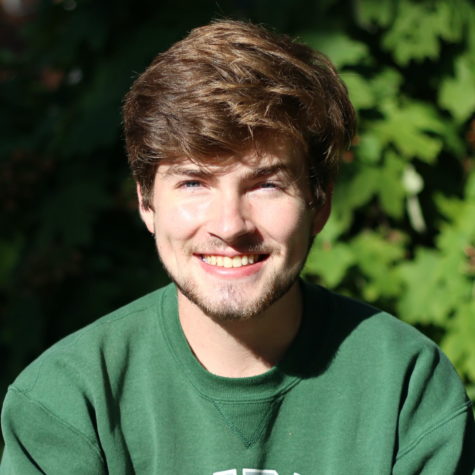Halloween’s 2,000-year-old history
November 1, 2019
Halloween is characterized by dressing in costume, eating copious amounts of candy and watching scary movies. However, Halloween’s history is believed to stretch back 2,000 years and includes a variety of pagan and Christian influences.
Many historians believe the precursor to modern-day Halloween was an ancient Celtic festival called Samhain, celebrating the day Celts believed the boundary between the living and the dead became most hazy.
“Samhain was a fall festival celebrating the fall harvest and the transition from the hot, light season to the cold, dark season,” explained Timothy Beal, Florence Harkness professor of religion and chair of the department of religious studies. “As a transition between seasons, it was believed to be a liminal or ‘in-between’ time, when spirits and fairies could enter the human realm more easily and the souls of the dead could return home.”
Samhain, like Halloween, was celebrated on Oct. 31. Celts celebrated by wearing animal heads and skins, building huge bonfires and sacrificing animals and crops. Celtic priests, called Druids, thought the closeness to the spirit world allowed them to make accurate prophecies on Samhain.
Interactions between the Romans and Celts caused the Romans to integrate their pagan traditions with Samhain. The Romans celebrated a festival honoring the dead in late October, which they called Feralia. They began to implement some of Samhain’s traditions into Feralia. Additionally, the Romans incorporated a celebration of Pomona, goddess of fruits and trees, into the combined celebration of the dead. Pomona’s symbol was the apple, which may have contributed to the practice of bobbing for apples becoming a part of Halloween tradition today.
After the fall of the Roman Empire, these festivals honoring the dead were incorporated into Christian tradition. In 609 A.D., Pope Boniface IV established All Saints’ Day, honoring the Catholic saints who did not have their own individual day, celebrated on May 13. The festival was later moved to Nov. 1. Then, in 1,000 A.D., Nov. 2 was made All Souls’ Day, in what many historians believe was an effort to supplant Samhain. All Saints’ Day became known as All-Hallows and Oct. 31, the night before, became known as All Hallows Eve, which eventually morphed into Halloween.
According to Beal, “‘Halloween’ comes from ‘hallow’ or ‘holy’ plus ‘even’ or ‘evening,’ and thus means ‘hallows evening.’”
The origins of trick-or-treating may have also developed in response to All Souls’ Day celebrations. During All Souls’ Day festivities, the poor would receive food from the rich in exchange for praying for the rich’s dead relatives. The Roman Catholic Church supported this practice in another attempt to subvert the pagan tradition of leaving food out for spirits.
Halloween traditions continued to change in the American colonial period. Initially, Halloween celebrations in colonial New England were rather limited. In the southern colonies, especially Maryland, which was founded as a Catholic colony, Halloween celebrations were much more common. Early American Halloween traditions included sharing stories of the dead, telling fortunes, dancing, singing and telling ghost stories.
Into the 19th century, Halloween was still not celebrated universally in the United States. However, as the number of Catholic immigrants grew in the latter part of the century, Halloween became popularized and celebrated widely. With this newfound popularity, some of Halloween’s traditions morphed to become distinctly American. Particularly, Halloween became much more secular in the 19th century. Community get-togethers and parties became mainstays of Halloween celebrations.
Immigrants in the 19th century also brought one of the most iconic elements of Halloween to America: the jack-o-lantern. An Irish myth about a man named Jack explains the origins of the jack-o-lantern. The story goes that Jack invited the Devil to have a drink with him. Jack, unwilling to pay for the drinks, convinced the Devil to turn into a coin, so that Jack could buy the drink. Instead of doing so, Jack kept the coin and prevented the Devil from turning back by placing the coin next to a silver cross. Later, Jack released the Devil, but made the Devil promise not to claim his soul if he died or bother him for a year. A year later, Jack again tricked the Devil, this time making the Devil promise to leave him alone for ten years. Before the ten years was up Jack died. True to his word, the Devil did not allow Jack into hell. God, on the other hand, would not allow Jack to enter heaven. Jack was forced out into the world with only a burning piece of coal, which he put in a carved-out turnip, to light the way. Jack became known as “Jack of the Lantern,” and then “Jack O’Lantern.”
Halloween continued to evolve through the 20th century. In the early part of the century, vandalism accompanying Halloween began to rise, which caused Halloween to develop into a holiday aimed at children. Dressing in costume and going trick-or-treating also became part of American Halloween tradition in the mid-20th century.
Today, Halloween is a widely celebrated holiday in America. Over 172 million Americans are estimated to have participated in Halloween activities this year. The average American spent almost $90 on goods related to Halloween.
Although the Halloween of today is very different from Samhain celebrated long ago, many traditions have survived over 2,000 years of change.
Regarding the incredible longevity of Halloween practices, Beal said, “What’s interesting is how so many elements from Samhain [turned] into Halloween traditions and practices—pumpkins and gourds and cider, dressing up like spirits or the dead, visiting neighbors door to door, feasting and drinking.”


